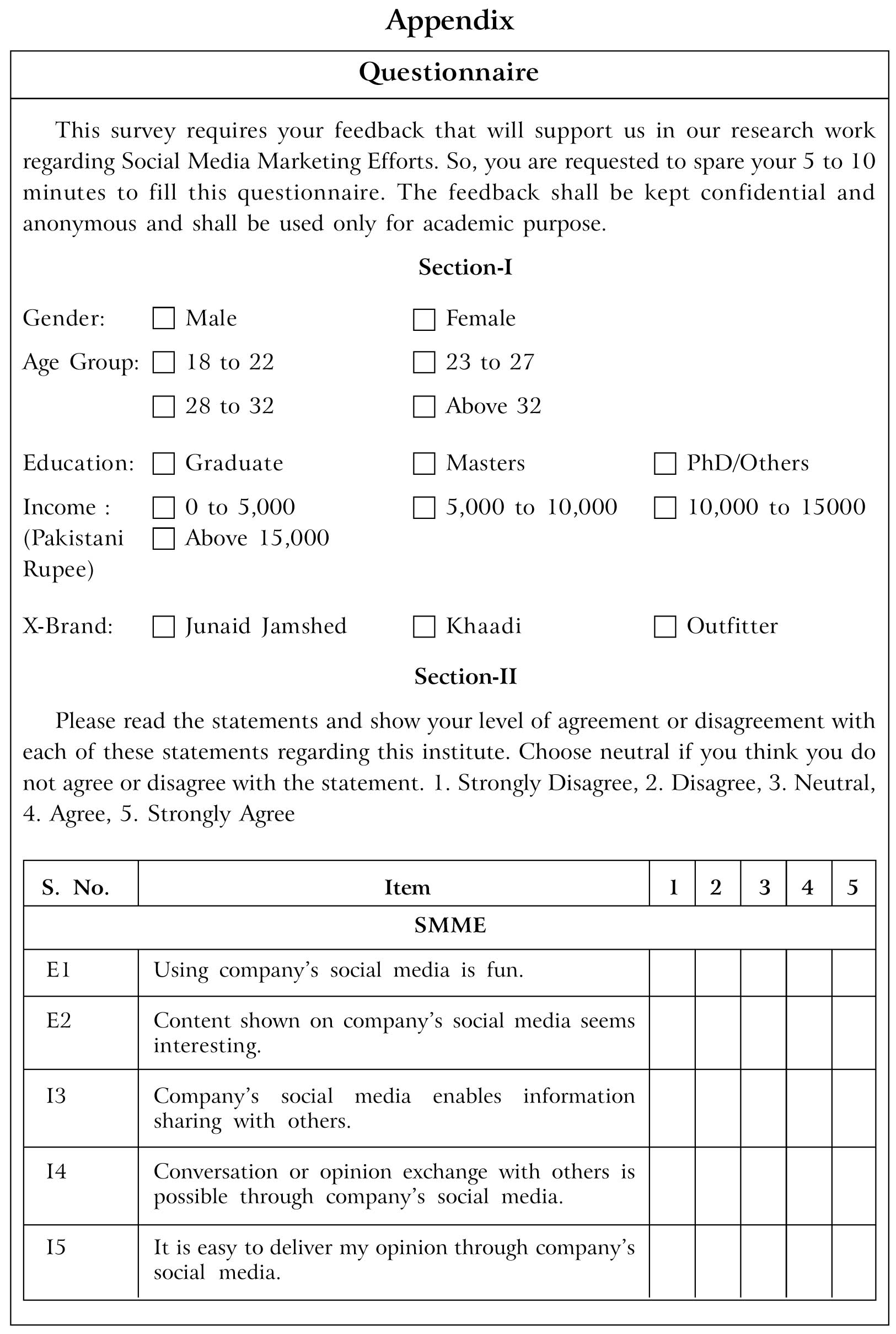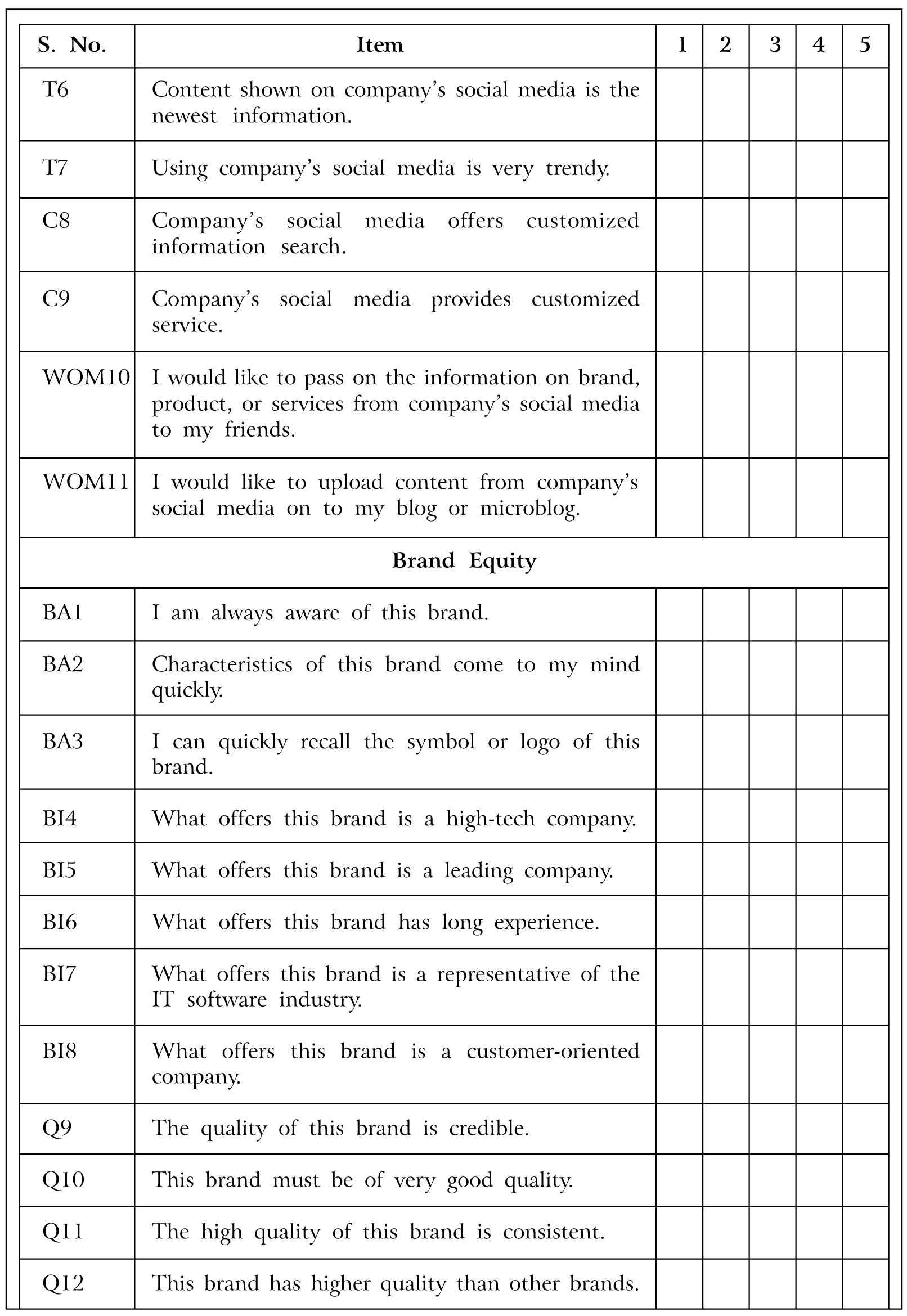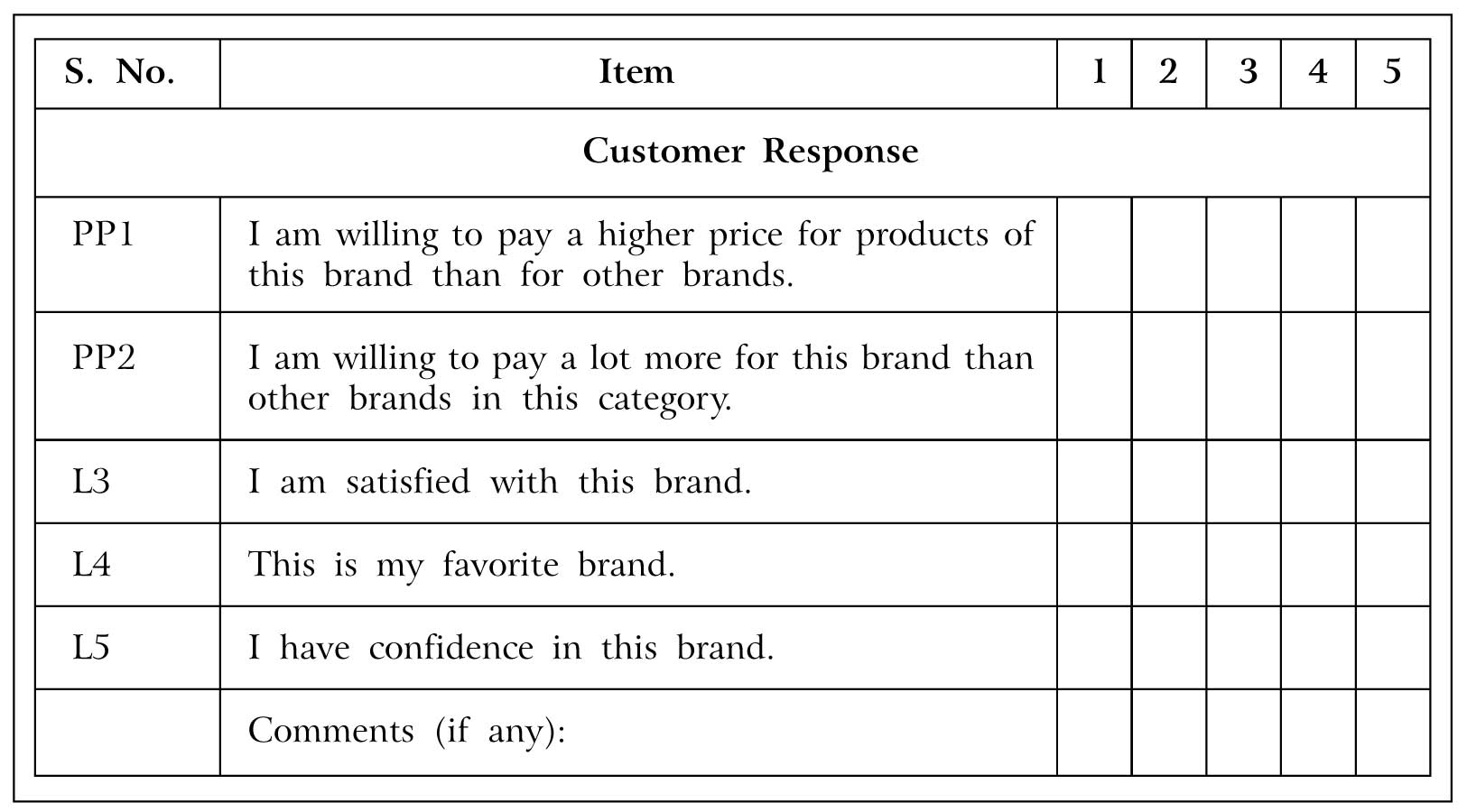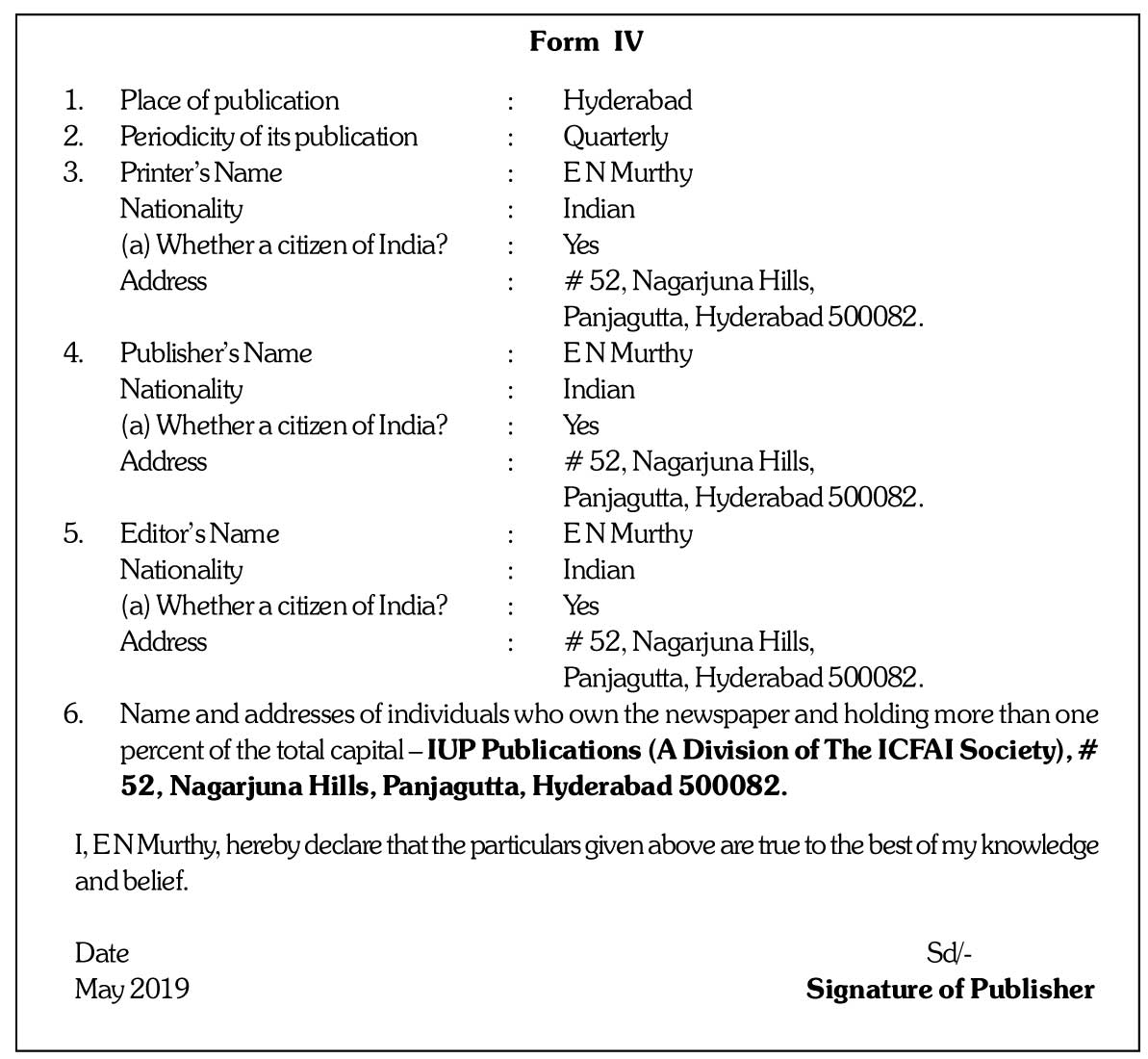
May'19
The IUP Journal of Marketing Management
Archives
The Influence of Social Media’s Marketing Efforts on Brand Equity and Consumer Response
Rida Sehar
MBA, Department of Management Sciences,
University of Sargodha,
Gujranwala Campus, Pakistan.
E-mail: seharrida19@gmail.com
Sarfraz Ashraf
MBA, Department of Management Sciences,
University of Sargodha,
Gujranwala Campus, Pakistan;
and is the corresponding author.
E-mail: sarfrax.ashraf@gmail.com
Faisal Azam
MBA, Department of Management Sciences,
University of Sargodha,
Gujranwala Campus, Pakistan.
E-mail: faisalazam402@gmail.com
This study investigated the impact of Social Media’s Marketing Efforts (SMME) on the brand equity of the consumers and their behaviors towards the brand. The relationship of these variables is explored by analyzing three different brands (Outfitters, Khaadi and Junaid Jamshed) in Pakistan. For data collection, a structured questionnaire was used with five elements of SMME, three dimensions of Brand Equity (BE), and three dimensions of Consumer Response (CR). The results of this study show that there is a positive and significant link between SMME and consumer behavior and brand equity. The results of the study also show that brands can improve their relationship with the customers by using social media sites. This study has addressed the gaps in the earlier studies of SMME of a brand through the structural equation model.
Introduction
According to Mangold and Faulds (2009), there has been a huge transformation in
social media in the last one decade. Due to the change in technology, changes in social
media websites are evident. And, according to the Internet World Stats (2013), 34%
population of the world is using these sites with the help of the Internet. Companies
and brands are trying to find new ways through which they can easily reach their
customers, make interactions and engage them with the brands (Gallaugher and
Ransbotham, 2010; and Kozinets et al., 2010). Nowadays, social media websites have
great influence on the consumers’ response to a brand or a product. The marketing
efforts on the social media sites of the brands are the main reason to create brand equity
and change the response. The customers of the brands are the followers of the brands on
these social media sites and follow the latest information. These sites enhance awareness
among the consumers and create a brand image. Consumers search these social media
sites for information regarding a specific brand. Therefore, these sites have a great influence
on consumers’ buying intention.
This study is a contribution to the prior studies on the marketing efforts of the
brands on social media sites and how they create their image in the mind of their
customers. Previous studies have focused on social media’s marketing effort of several
brands by utilizing their online resource. This study aims to focus on how the consumers’
buying intentions are influenced by these social media sites’ marketing efforts. The prior
studies focused on luxury brands, that is, how the marketing activities on social media
influence consumers’ response by creating brand equity, whereas this study examines
the national brands of Pakistan and as to how the marketing efforts of these brands have
an impact on consumer response.
The purpose of this study is to examine the influence of the marketing activities of
social media on consumer buying behavior and brand equity. Only two dimensions of
brand equity were studied in the previous research (brand awareness and brand image),
but the current study has incorporated brand quality as a third dimension of brand
equity.
Literature Review and Formulation of Hypotheses
Social Media Marketing Efforts
Social media is explained by Safko and Brake (2009, s.6) as “activities, practices, and
behaviors among communities of people who gather online to share information,
knowledge, and opinions using conversational media”. In the last decade, a lot of changes
have occurred in the media and it has experienced a lot of transformation (Mangold
and Faulds, 2009). The forecasting process completed by The Boston Consulting Group
(2014) had indicated that by 2016 there would be a growth in the Internet economy by
$4.2 tn. According to the Internet World Stats (2014), the Internet users have been
increasing day-by-day and cover 40.7% of the world’s total population.
Social media is basically a place where marketers can communicate with their
consumers or potential customers and through which they can create a relationship
with strong association (Kelly et al., 2010). Social media provides a platform for both
the brands and the customers for interaction and sharing information with each other
(Richter and Koch, 2007). These applications and platforms include social blogs, podcasts,
weblogs, microblogging, wikis, pictures, videos and social bookmarking. The use of these
applications are on the rise for the sake of communication as the business firms are using
these as tools for communicating with their customers.
Social media plays a very important role in the success of a brand (Phan et al.,
2011). Kapferer (2012) pointed out that catwalk presentation videos are posted by
Louis Vuitton (LV) on its Facebook page which gives an opportunity for the fans of LV
to view the latest fashion and enjoy the activities of the show. An online chat system has
been introduced by Burberry that provides 24-hour customer service. The Chinese
customers of Burberry can make online purchase and can give feedback through the
online customer service. The popular social media networking sites in China are
kaixin001.com and douban.com that are used for online shopping. The local celebrity
followers of Burberry on Weibo (a microblogging service) rose from 90,000 to 180,000
from early 2011 to January 2012 (Spillecke and Perrey, 2012).
The five dimensions of social media marketing efforts of a brand are explained by
Kim and Ko (2012) as: interaction, entertainment, customization, Word-of-Mouth
(WOM), and trendiness. The social media marketing efforts are examined through the
five perspectives of Kim and Ko’s (2012) as follows:
Interaction
The interaction on social media is basically a mode of communication in which the
exchange of information takes place (Gallaugher and Ransbotham, 2010; and Kaplan
and Haenlein, 2010). According to Daugherty et al. (2008), social interaction works as
a motivator because it helps to create the content according to the users’ point of view.
Social media provides a place for the customers where they can discuss and share their
ideas with others. Muntinga et al. (2011) described social media interaction as a platform
where the users interact with each other, contribute to the discussion, give suggestions
on specific products or services and likeminded people meet to express their views on
specific issues. The objective of this shared information is basically to connect the media
users with the information and keep them up to date. The integration with the user is
encouraged because the focus is on the user who is beyond the profile (such as on
WhatsApp, Facebook, Instagram, and Twitter).
The contents include the discussion topics and the comments of the user on that
specific topic (e.g., on YouTube, Pinterest, Instagram). The unique information should
be there on the social media sites related to the brands, the reflection of the members’
profile and the discussions must be helpful for the users shared by the members. The
relationship between the brands and the users can make a cause for increasing the
affinity and credibility (Manthiou et al., 2013).
Entertainment
According to Agichtein et al. (2008), enjoyment and play, which are caused by experiencing social media activities, result in entertainment. The users who are having fun and entertainment and experiencing a lot of enjoyment are basically the pleasure seekers on social media sites (Manthiou et al., 2013). A person who is entertained will participate in social networks (Park et al., 2009). Social media networks are used for the purpose of entertainment to some extent. The social media users consume their time on social networks for the sake of enjoyment. The contents which are related to brand on social media networks are also consumed by the users for refreshment and enjoyment purpose (Muntinga et al., 2011).
Customization
Customization is an activity in which the customers’ point of view is more important to prepare the services. The main motive of customization is customer satisfaction (Schmenner, 1986). The social media sites of a brand can be customized according to the customers’ requirements and should express individuality. This will lead to building loyal customers of the brand (Martin and Todorov, 2010). Zhu and Chen (2015) described that the customization level of the messages that are posted on the social media site of any brand are of two types: a broadcast and a customized message. The target audience for a broadcast message is anyone on the social media site who is interested and for the audience in general (e.g., twitters tweets). But a message which in customized form is usually for a small group of people or for a particular person (e.g., Facebook posts). For example, Burberry and Gucci use their online sites to increase their customer base and to satisfy their customers. They create personalized messages for their consumers and make products or deliver services according to the customer’s requirements (Sangar, 2012). The definition of the customization is the extent to which customized information, as well as customized service, is provided by the social media channel.
Word-of-Mouth (WOM)
The consumers’ interaction with eWOM about a specific brand is possible due to social media. It associates the online interaction of the consumer to the consumer with eWOM (Muntinga et al., 2011). It is a known fact that more information regarding branding is in the form of opinions, discussions, and comments that are generated through consumer posts. Chu and Kim (2011) explain that the three perspectives of the use of eWOM examined by the researchers on social media are: opinion seeking, opinion giving, and opinion passing. The consumers who search for information regarding the brands and take advice from experienced consumers are basically the opinion seeker. They want to get the opinion from other consumers before using the brand. Opinion-giving behavior includes the persons having an influence on consumer behaviors and their attitudes. They are also called opinion leaders. Finally, the opinion-passing behavior consists of consumers having the characteristics of eWOM. The online flow of information is facilitated by the persons having opinion-passing behavior characteristics.
Trendiness
The latest news regarding specific brand and discussion topics are provided by the
social media. Social media provides all the latest information related to the brands to
the consumers (Naaman et al., 2011). Consumers consider the information which is
given on the social media more trustworthy than the information which is provided by
the traditional sponsor of the brand (Vollmer and Precourt, 2008; and Mangold and
Faulds, 2009). Muntinga et al. (2011) explain that the four sub-motivations covered by
the trendy information which is provided on social media are: knowledge, inspiration,
surveillance and pre-purchase information. Knowledge is all about the information which
is related to the brand that is obtained by the consumer from another consumer’s expertise.
The purpose of acquiring information related to a brand or product is to gain profit
through other's knowledge. In pre-purchase information, the buyer reads all the related
information which includes the reviews of the product and the drawbacks of that product
from the social communities of that particular brand. Surveillance means that the
observation of a brand’s social environment. The consumer wants to be up-to-date about
all the factors on which the social environment depends on. Finally, inspiration is related
to the person who gets the whole information associated with the brand given to the
community on social media and obtains the innovative ideas from that information.
The person becomes a source of inspiration to others who acquire that given information
and generates ideas from that.
Why are there only five dimensions of marketing efforts of social media? Social media
is a broader concept and this study includes only the five dimensions of the marketing
efforts of social media. According to Stokburger-Sauer et al. (2012), brands provides the
opportunities for the consumers to connect with each other on social media websites,
thus leading to the creation of brand engagement, which could be a dimension of it.
Brand identification could also be enhanced due to the marketing efforts of social media.
The five dimensions of the marketing activities of social media are included in this
study. There could be other dimensions of social media activities associated with the
marketing of a brand. There is very limited research on these variables in Pakistan.
These variables could be studied in more detail in further research.
Brand Equity
Brand equity is defined by Aaker (1991, p. 15) as “a set of brand assets and liabilities
linked to a brand, its name, and symbol that add to or subtract from the value provided
by a product or service to a firm and/or to that firm’s customers”. Keller (1993) defines
it as “the differential effect of brand knowledge on consumer response to the marketing
of the brand”.
Brands create a sense of differentiation from others and build their own image in the
mind of customers that there is something special which is different from others (Keller,
1998). Brand equity normally depends on three key criteria which are: the attitude of
the consumer regarding that brand, brand awareness, and finally the corporate ethics
(Lemon et al., 2001; and Ashraf et al., 2018a).
There are mainly two reasons for which a person purchases a luxury brand: the first,
is for his or her personal satisfaction and the second is that the luxury brands represent
a symbol of success. This is further supported by Kapferer and Bastien (2009). A balance
between these two motivations is required for the better future of the luxury brands.
The balance between these motivations may vary from place to place (e.g., geographical
boundaries). For example, the countries where the luxury products and brands are just
a new experience for the consumers, and on the other hand, the countries where the
production and consumption of the luxury brands take place traditionally (Kapferer
and Bastien, 2009). According to Godey et al. (2016), brands are the basic platform
where they can connect with their consumers and become aware of their needs and
wants, irrespective of the purchase motivation. The brands have a great influence on
consumer behavior and attitudes. There are several ways through which a brand can
influence a consumer such as the perception regarding the image of the brand, brand
awareness, and the consumers’ preferences about that specific brand. The model of
brand equity as defined by Keller (1993) consists of two dimensions: brand image and
brand awareness. The third dimension which is added in this study is brand quality.
Brand Awareness
“Brand awareness refers to the strength of the brand node or tracing brand consumer’s mind, which states consumer’s ability to identify the brand under different conditions” (Rossiter and Percy, 1987). Brand awareness is basically the condition in which a consumer can easily identify the brand among other competitive brands. Brand awareness further consists of brand recall and brand recognition. Brand recall is defined as how easily and quickly a consumer can recall it from one’s memory. Brand recognition is defined as how quickly a consumer can identify the brand and differentiate it from other brands if a cue related to that specific brand is given to the consumer for the identified purpose.
Brand Image
Keller (1993) explains brand image as the impression of the brand which is reflected in the customer’s memory. It takes time to develop a brand image in the customer’s mind. According to Aaker (2003), brand image is basically how a consumer thinks about the brand and how it will be recognized by the consumer. Brand image is established by the symbolic elements or through the experimental and functional elements. According to Keller (1998), brand image is like the image of the brand which is associated with the consciousness of the consumer’s mind.
Brand Quality
According to Bruks et al. (2000) and Pappu et al. (2006), quality dimensions are
established to measure and determine the quality level of any brand’s product or services.
Lee et al. (2011) explain that when the brand’s excellence is analyzed collectively it is
referred to as brand quality. It consists of all the attributes of the brand, whether they
are tangible or intangible. According to Cole and Flynn (2009), “Perceived quality can
affect a willingness to buy, and the price that customers will pay”.
This study is limited to the investigation of the three dimensions of brand equity.
There should be other dimensions of brand equity, such as the re-evaluation of the
creation process of brand equity and brand association. Future research could incorporate
these dimensions also.
Consumer Response
Kim and Ko (2012) explain that the settings of social media are creating brand equity in the customers’ mind and the marketing activities of these social media sites are the main source to generate the need in consumers and potential customers to purchase the brand. These marketing activities help the brands create a positive intention in the consumers to purchase the brand, and then consumers respond positively to these marketing tactics. According to Aaker (1991), Keller (1993 and 2013), and Keller and Lehmann (2006), the brand having stronger brand equity will lead to increase in brand preference among the customers; the customer will be willing to pay a premium price, and finally the customer will be loyal to that brand.
Brand Preference
Keller (2013) defines brand preference as there are several competing brands in the market, a consumer prefers a brand on the basis of the information available to the consumer related to the brand and due to the emotional attachment with that brand. Consumers are being asked to select a brand among several brands in the category to measure brand preference.
Price Premium
Netemayer et al. (2004) described that the price premium is the price which the customers are willing to pay for the specific brand over other brands. The customers are willing to pay a higher price to a brand which they are loyal to, even if it is much higher than the price of other brands.
Brand Loyalty
Brand loyalty is a condition in which the consumer is willing to purchase the brand in
the future (Ashraf et al., 2017 and 2018a). Lam et al. (2010) explain the concept of
brand loyalty as “a deeply held commitment to rebuy or repatronize a preferred product/
service consistently in the future, causing a repetitive same brand or same brand-set
purchasing, despite situational influences and marketing efforts having the potential to
cause switching behavior.”
This survey depends on the three main dimensions of consumer response. There are
many dimensions of consumer response which could be used for future research work.
There is very limited research work on price premium and brand preferences in Pakistan.
These dimensions have very huge potential, which could be explored in further research.
Marketing Efforts on Social Media and Consumer Behavior
Godey et al. (2016) presented the findings of a study in which the efforts of marketing
of a brand on social media are treated as an independent variable and consumer response
as a dependent variable. In this survey, the data is collected by the consumers
quantitatively from four selected countries. This study proves that social media’s efforts
in marketing a brand has a direct and positive influence on consumer behavior.
Kim and Ko (2010) explain the relationship of the marketing activities of social
media and purchase intentions of the consumer, which could reflect in consumer
response as well. This study proves that social media marketing positively and
significantly influences the purchase intentions of the consumers. The data was collected
through a questionnaire. In this survey, the respondents (150) were the consumers of
the luxury brand in the Seoul area. The research was conducted randomly on 211
Internet users.
The research work of Hung et al. (2011) explains that there are three independent
variables: social influence is one of them which influence the purchase intention. This
survey has 1,380 valid responses from 1,750 respondents in Taiwan and proves the
variables are positively linked. Bruhn et al. (2012) also explain the positive and significant
link of social media communication and purchase intentions by conducting an online
survey of 393 participants.
Kim and Ko (2012) conducted a survey with 400 respondents to explain the positive
and significant relationship of variables on how the marketing activities of social media
have an impact on consumer response, which is directly affected by a mediating variable
(brand equity). Zhang and Kim (2013) prove that social comparison positively influences
the attitude of the consumers towards the purchase of luxury brands; the mediating
variable further has a positive influence on purchase intentions of the luxury brands.
Hence, this study reveals that there is a positive and significant link between social
media and consumers’ purchase intentions.
Wang et al. (2012) define the relationship by conducting an online survey of 935
participants. Peer communication on social media has an influence on the product
attitude, which in turn is a cause to enhance the purchasing intentions of the consumers
towards a brand. The findings of the research prove that peer communication on social
media positively influences online consumers. Another research survey proved that social
customer relationship management capabilities are positively influenced by the use of
technology on social media. The data was collected randomly from 1,200 firms in the
US. The participants included the top management team members of the firms. The use
of technology enables the firms to serve their customers in a better way which will affect
consumer behavior (Trainor et al., 2014; and Iftikhar et al., 2017).
The marketing efforts of social media have a great influence on consumer behavior
while purchasing any product or service. The marketers of the brands should be aware
of these marketing activities on social media because through these activities they can
influence their potential customers to buy their product. This concept has been worked
upon negligibly in Pakistan; the researchers should define the relationship between these
two in detail, which will be informative for the marketers.
H1: Marketing efforts on social media have a positive and direct influence on consumer
response, i.e., consumer preference, brand loyalty and willingness to pay a premium
price.
Social Media’s Marketing Efforts and Brand Equity
Kim and Ko (2012) conducted a survey of 400 consumers to prove the relationship
between the variables, and the survey proves that the perceived marketing activities of
social media have a positive impact on brand equity. Social media activities have a
positive and significant relationship with brand equity.
Godey et al. (2016) describe the positive and significant relationship of the marketing
activities of social media with brand equity. The marketing activities of social media are
treated as an independent variable which influences brand equity of the consumers,
which in turn affects consumer behavior. The study was conducted on the consumers of
four different countries (China, France, India, and Italy). 845 respondents were selected
to analyze the data, and the results prove that there is a positive and significant
relationship between them. Schivinski and Dabrowski (2016) explain that there are
two types of social media: the first type is the social media which is created by the firm
and the second one is user-generated. Both types of social media are treated as an
independent variable which has a positive influence on brand equity, which is treated
as a mediating variable in this study. This survey proves that social media has a positive
and significant relationship with brand equity. Annie Jin (2012) further describes the
relationship between a brand’s marketing on its social media pages such as Facebook.
This research proves that the marketing activities on Facebook create a sense of awareness
in consumers and then they want to explore the brand and want to revisit it. This study
proves the positive and significant impact of social media in the creation of brand
equity in the consumers’ mind.
The relationship between the marketing activities of a brand on social media and
brand equity has the greatest influence on the consumer market. The research regarding
the relationship of these variables is very limited in Pakistan. These variables should be
explored to briefly understand the consumer needs.
H2: The marketing efforts of a brand on social media have a positive and significant
effect on consumer-based brand equity.
Brand Equity and Consumer Response
Bruhn et al. (2012) tested the link between consumer-based brand equity and consumer
response by conducting an online survey. Double mediation technique is used in this
research work. The dimensions of brand equity tested in this research survey are brand
awareness and hedonic brand image, and their relationship with consumer purchase
intention. The results show a positive relationship between the variables. Kim and Ko
(2012) also conducted a research survey to prove brand equity’s positive relationship
with consumer purchase intention. Godey et al. (2016) explain the positive and
significant link between social media marketing efforts with the consumer behavior,
which is affected by the mediating impact of brand equity.
Schivinski and Dabrowski (2016) chose three categories of products to examine the
impact of brand equity on consumer behavior. The product categories included mobile
network operators, clothing, and non-alcoholic beverages. This research proves the positive
and significant influence of brand equity on consumer purchase intentions. There is limited
research on the relationship between consumer behavior and brand equity. These should
be explained in detail in Pakistan to enhance consumers’ response to this research.
H3: Brand equity has a positive and direct impact on consumer response.
Mediation of Brand Equity
Styles and Ambler (1995) treated brand equity as a marketing asset, the asset which
helps in creating a bond between the customers and the firm. This marketing asset
establishes a long-term relationship and generates a buying behavior among the public
(Keller, 2013). According to Keller (1993), the companies or brands can attract customers
and potential customers towards their brands or products by influencing their brand
equity. And companies influence their customers by creating an emotional connect by
which they strengthen their association with brands or products (Keller, 1993). The
companies use social media in their marketing campaigns to influence the customers.
Further, the previous studies by Godey et al. (2016) had claimed that the marketing
activities through social media positively influence brand equity. Schivinski and
Dabrowski (2016) also examined the relationship between both and proved that
communication of the firms with their customers through social media has a direct and
positive relationship. This concept has also been proved by numerous scholars that the
social media marketing activities of a brand or product have a positive and significant
relationship with brand equity and its dimensions, such as brand awareness, brand
image, etc. (Bruhn et al., 2012; and Kim and Ko, 2012).
Firms attract customers by influencing their brand equity with the help of social
media marketing efforts. These marketing activities bring positive change in consumer’s
buying intention. When the brand equity of a specific brand is generated, the consumer
will pay more for that brand, prefer the brand over the other brands and become a
loyal customer of the brand (Aaker, 1991; Keller, 1993 and 2013; and Keller and
Lehmann, 2006). This concept of brand equity and purchase intention relationship
has also been investigated by Kim and Ko (2012). When the purchase intention of
the consumers changes, then their response towards the brand will also change (Kim
and Ko, 2012).
Kim and Ko (2012) revealed that brand equity is also studied as a mediating variable
between the marketing efforts of social media and purchase intention which results in
consumer response. Schivinski and Dabrowski (2016) also explored the positive link
between the marketing efforts of social media and consumer purchase intentions by
using brand attitude as a mediating variable. Another research work by Bruhn et al.
(2012) showed the relationship of social media communication and consumer behavior
by using the dimensions of brand equity as mediating variables.
Kim and Ko (2012) and Schivinski and Dabrowski (2016) used brand equity as a
mediating variable in their research studies. Bruhn et al. (2012) also investigated the
relationship variables by using the dimensions of brand equity as a mediating variable.
Brand equity is used and recommended by Godey et al. (2016) as a mediating variable
in their research studies.
H4: Brand equity has a mediating effect between the marketing efforts of a brand on
social media and consumer response.
Data and Methodology
Sampling Procedure
This is a cross-sectional study and quantitative in nature. This study used a convenient sampling technique to approach the target audience. Data was collected during the period of May 2, 2018 to June 7, 2018. A questionnaire (see Appendix) was designed to conduct the survey and the data was collected from 360 respondents, out of which only 200 were valid responses. The data also included the responses of online respondents too. The respondents were social media users of the brands and follow the brand on social media websites. The brands selected for the research survey are: Junaid Jamshed, Khaadi and Outfitters. Quantitative techniques have been used in this research study. The target audience in this research study is the students who are the followers of the selected brands.
Measurements
To measure all the constructs, a five-point Likert scale was used to evaluate the perceptions of the consumers. All scales were adapted from the previous research studies. The scale of social media marketing efforts was adapted from the study by Kim and Ko (2012), who had stated that SMME possess five dimensions, viz., entertainment, interaction, trendiness, customization and word-of-mouth (Figure 1). So, this study also used all five dimensions of SMME. The scale of brand equity was adopted from Kim and Hyun (2011); they include brand awareness, brand image and brand quality as the sub-
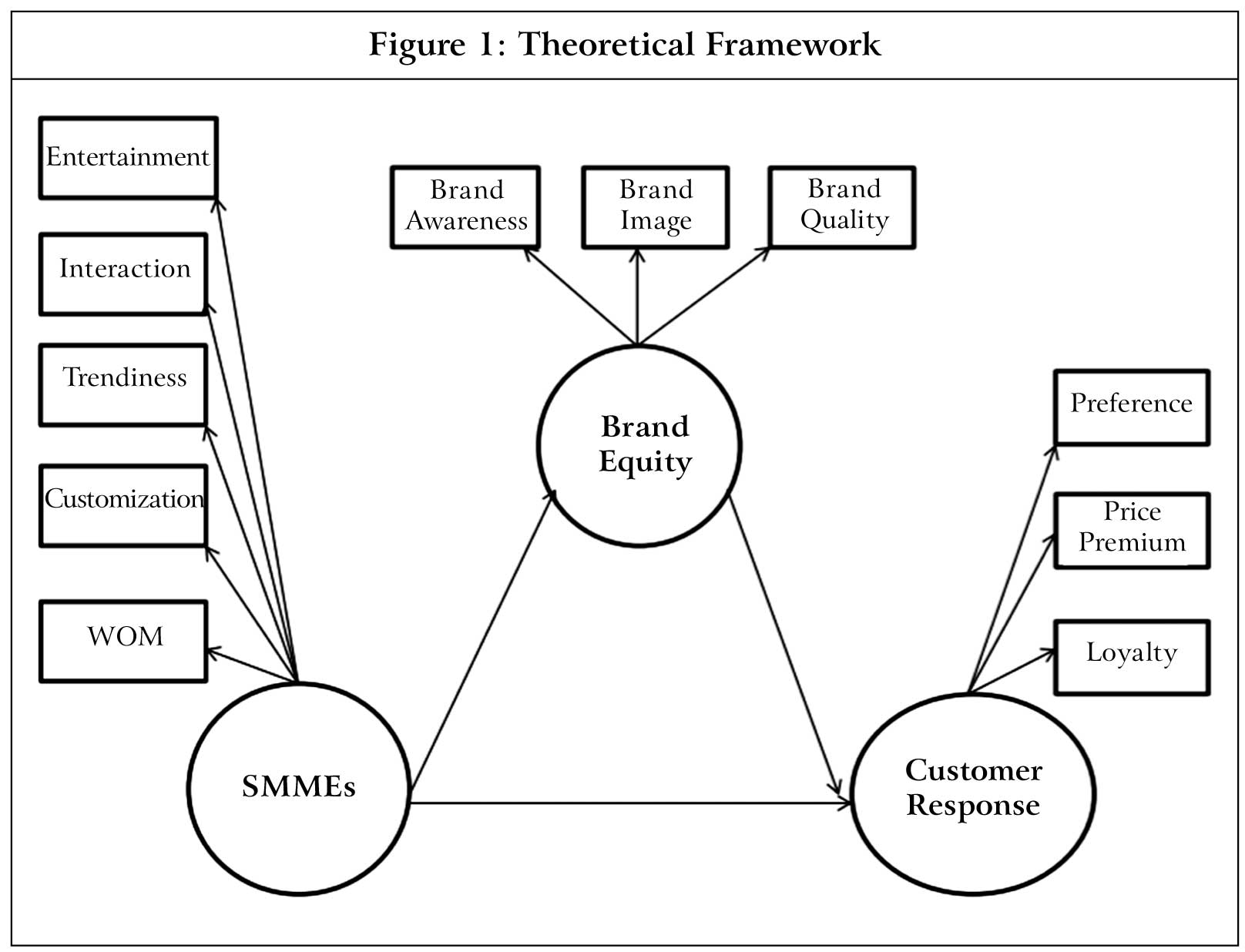
constructs of brand equity. And this study also used all these three scales as the sub-scales of brand equity. Consumer response is based on its three dimensions, viz., brand preference, willing to pay a premium price and brand loyalty. Thus, the scale of brand preference was adapted from the study of Kim and Hyun (2011), the scale of willing to pay from the study of Netemeyer et al. (2004), and the scale of brand loyalty from the study of Yoo et al. (2000). The sample consists of 55% males and 45% females (Table 1). About 56% of the respondents were graduates, 37.5% had Masters degree and 6.5% were PhDs. The respondents were asked to express their opinions with regard to the selected brands.
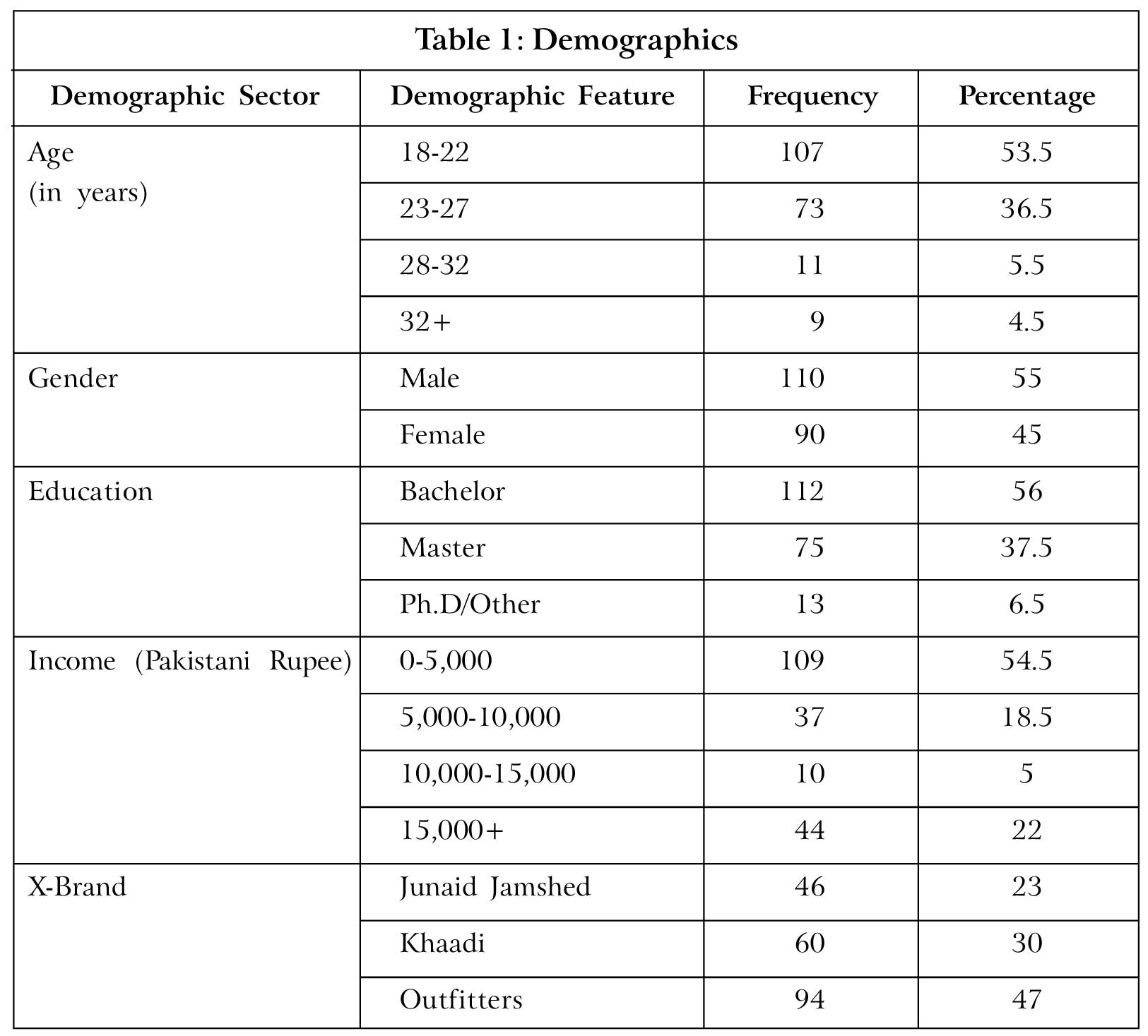
Results and Discussion
Reliability Test
Reliability test (Table 2) was employed to ascertain the reliability of the used scales. Nunnally and Bernstein (1994) recommended that the value of reliability must be greater than 0.70. However, the reliability values of SMME, BE and CR are 0.75, 0.71 and 0.81 respectively, which shows that the scales are reliable for further analysis.
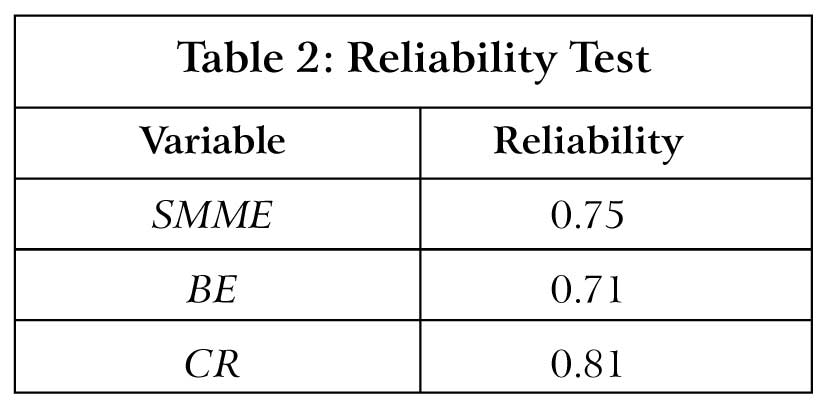
Descriptive Statistics and Pearson Correlation
Table 3 shows the values of the mean and standard deviation of the variables, i.e., SMMEs, Brand Equity (BE), and Consumer Response (CR). The mean value of SMMEs is 2.57 with 0.679 standard deviation which showed 68% variation in the responses. The values depict that the marketing efforts on social media are correlated positively and significantly with (r = 0.673, 0.685) BE and CR at p < 0.01. BE’s mean value is 2.41 with 0.77 standard deviation; the values of standard deviation portrayed 77% variation in the responses. The values show that BE is positively and significantly correlated with (r = 0.685) CR at p < 0.01 respectively. The results depict that most of the respondents agreed. Finally, the mean value of CR is 2.52 with 0.653 standard deviation. The values showed that there is a 65% variation in the responses.

The table shows the correlation between the variables under study. The results show that there is a positive and significant relationship between the SMMEs, BE, and CR. The initial hypotheses are supported by these results.
Regression Analysis
Table 4 shows the positive and significant relationship between SMMEs and CR. Moreover, R2 = 0.483 indicated that 48% of the total variation in the CR is due to SMME. The table also shows that F = 193.255 and P < 0.01 which indicates that the results are statistically significant. These results support H2, that there is a positive and significant relationship between the SMME of a brand and CR (Table 4).

Mediating Analysis
Mediation (Table 5) was carried out by using AMOS 23.0 in two parts. In the first part, the study uses the entire mediation model and the second part was run to ascertain the direct effect. Model fit indices for both direct and indirect effects portrayed good fit as the values of Goodness Fit Indices (GFI) and Comparative Fit Indices (CFI) must be greater than 0.9. The values of root mean residuals and root mean square error of approximation must be less than 0.08. The mediation is in four structural paths, as suggested by Baron and Kenny (1986). Path (a) represents the effect of SMME on brand equity. Path (b) shows the effect of brand equity on consumer response. In path (c), the effect of SMME on consumer response has been checked with the presence of mediating variable, i.e., brand equity and the path also known as an indirect effect. Path (c) represents the effect of SMME on consumer response in the absence of the mediating variable, and it is known as direct effect. The table portrays that all paths are significant. As suggested by Baron and Kenny (1986), if the value of the indirect effect is greater than the value of the direct effect, it means that mediation exists. And when the direct effect is significant, it means partial mediation exists, and when the direct effect is insignificant, it means full mediation exists. The table shows that the value of direct effect is greater than the value of indirect effect and it is also significant, which means in our model partial mediation exists.
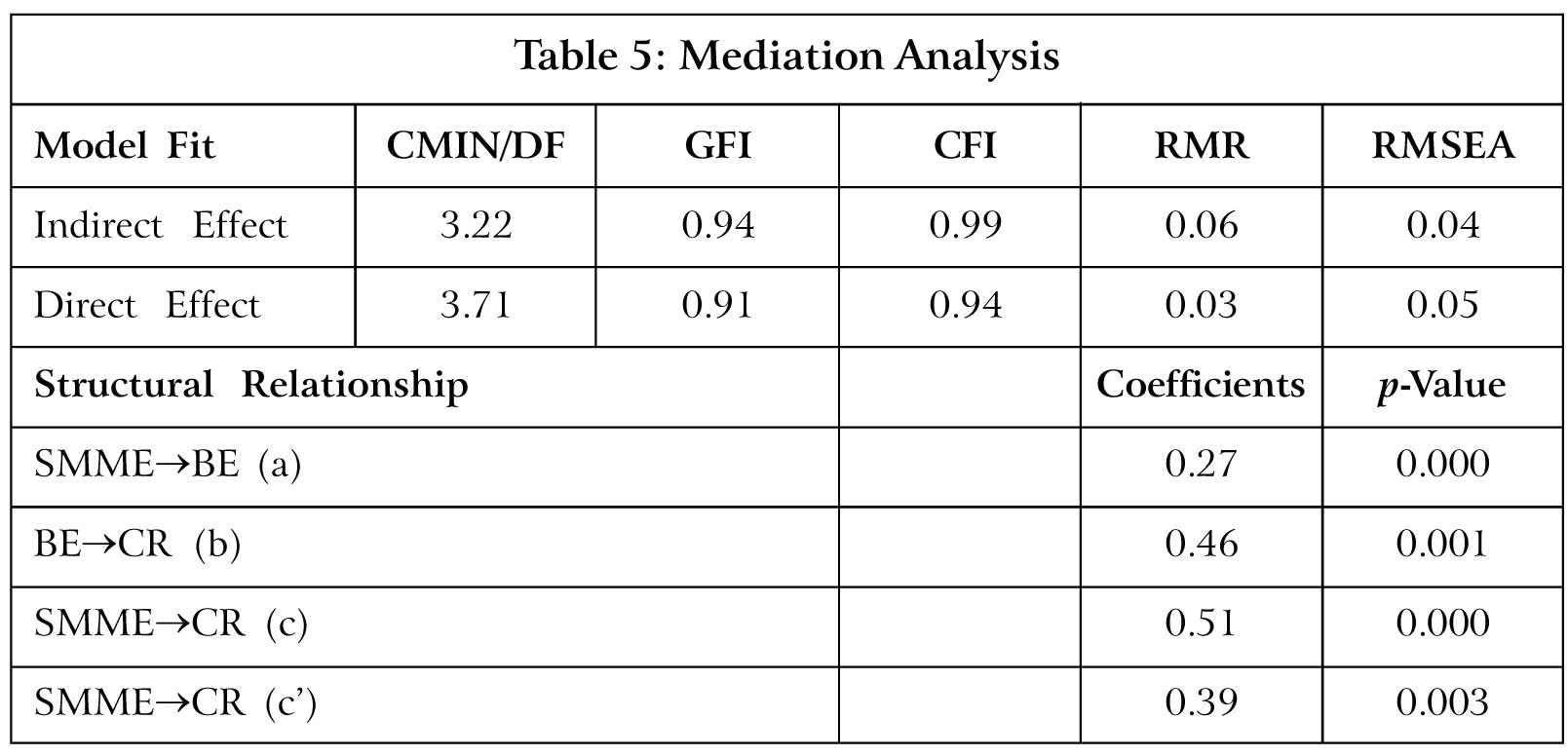
Conclusion
This study investigates the influence of SMME on consumer-based brand equity and
consumer response. The study is a contribution to the existing literature on the impact
of SMME on brand equity as well as consumer response. SMME consists of five elements,
viz., entertainment, trendiness, customization, interaction, and word-of-mouth. There
are three dimensions of BE, which are brand awareness, brand image, and brand quality.
And CR also consists of three dimensions which are premium price, customer preferences,
and loyalty. The results of the study are statistically significant. SMME help to engage
the customers with the brands by creating brand equity.
H1 proved that the SMME have a positive and direct influence on consumer response.
The results of the hypothesis are positive and significant. Godey et al. (2016) also used
SMME as an independent variable and consumer response as a dependent variable in a
study. The results of their study proved that SMME have a positive and significant
impact on consumer response. Kim and Ko (2010) also considered the relationship of
SMME as an independent variable and consumer response as a dependent variable and
proved that there is a positive and significant relationship between them.
H2 proved that SMME are positively and significantly related to the consumer-based
brand equity. Kim and Ko (2012) also proved this relationship in their study, that
SMME and BE are positively and significantly related. Godey et al. (2016) proved that
SMME positively and significantly influence brand equity. Hudson et al. (2016) tested
the relationship of these two variables in a research survey and proved that the interaction
of the consumers with brands on social media sites helps to improve the consumer brand
relationship.
H3 proved in this study is that there is a positive and direct influence of brand equity
on consumer response. Bruhn et al. (2012) tested the relationship of brand equity and
consumer response and the results confirm the findings of the previous researchers.
Another research study by Schivinski and Dabrowski (2016) proved that there is a
positive and significant relationship between the variables. The study by Kim and Ko
(2012) also supports the findings, i.e., brand equity is positively and significantly related
to consumer response.
H4 proved that brand equity positively and significantly mediates the relationship
between SMME and consumer response. Schivinski and Dabrowski (2016) and Kim
and Ko (2012) also use brand equity as a mediator between SMME and CR and prove
that there is a positive and significant relationship among the variables. In another
study, Godey et al. (2016) used brand equity as a mediator between SMME and CR,
and the results reveal that BE positively and significantly mediates the relationship
between the independent and dependent variable.
The results of the study reveal that the brands can improve their relationship with
the customer by using social media sites. The relationship of brands with customers
helps to convince the customer to prefer their brand and become loyal. And when the
customers become loyal to the brand, they will be willing to pay a premium price.
This study includes five dimensions of SMME which are entertainment, interaction,
customization, trendiness, and WOM. It includes the dimensions of brand equity, namely,
brand image, brand awareness, and brand quality. Consumer behavior also depends on
three dimensions, namely, premium price, preference, and loyalty. Prior research has
been conducted on penetrating luxuries brands and such findings were similar to the
findings of other industries. These findings for the industries in Pakistan in creating
brand equity would be useful in the customers’ minds. Social media sites are used for
entertainment and interaction. The industries can influence their customers by using
social media sites to market their brands. Positive word-of-mouth has great influence on
a customer’s mind while purchasing a brand.
Limitations and Future Scope:
The first limitation of this study is the socio-demographic
factor which includes age, gender, income, and education. It should be included as a
moderating variable in future studies to thoroughly understand the studied phenomenon.
Second, this study has taken into consideration the three dimensions of brand equity
—brand image, brand awareness, and brand quality. Other dimensions of brand equity,
such as brand association and re-evaluating brand equity creation process should be
incorporated in future studies.
Third, the findings of this study are restricted to Pakistan’s cultural context. Future
research could be conducted on other cultures for an indepth understanding of the
concepts.
References
- Aaker D A (1991), Managing Brand Equity: Capitalizing on the Value of a Brand Name. ( Управление капиталом бренда: повышение стоимости фирмы за счет ц)енности бренда счет ценности бренда ).
- Aaker D (2003), “The Power of the Branded Differentiator”, MIT Sloan Management Review, Vol. 45, No. 1, p. 83.
- Agichtein E, Castillo C, Donato D, Gionis A and Mishne G (2008), “Finding High-Quality Content in Social Media”, in Proceedings of the 2008 International Conference on Web Search and Data Mining, pp. 183-194, ACM.
- Annie Jin S A (2012), “The Potential of Social Media for Luxury Brand Management”, Marketing Intelligence & Planning, Vol. 30, No. 7, pp. 687-699.
- Ashraf S, Ilyas R, Imtiaz M and Tahir H M (2017), “Impact of CSR on Customer Loyalty: Putting Customer Trust, Customer Identification, Customer Satisfaction and Customer Commitment into Equation: A Study on the Banking Sector of Pakistan”, Int. J. of Multidisciplinary and Current Research, Vol. 5, Nov/Dec 2017 Issue.
- Ashraf S, Ilyas R, Imtiaz M and Ahmad S (2018a), “Impact of Service Quality, Corporate Image and Perceived Value on Brand Loyalty with Presence and Absence of Customer Satisfaction: A Study of Four Service Sectors of Pakistan”, Sciences, Vol. 8, No. 2, pp. 452-474.
- Ashraf S, Iftikhar A, Yameen A and Younas S (2018b), “Empirical Relationship of Customer Brand Engagement with Satisfaction and Loyalty Through Online Brand Experience”, The IUP Journal of Brand Management, Vol. 15, No. 3.
- Baron R M and Kenny D A (1986), “The Moderator-Mediator Variable Distinction in Social Psychological Research: Conceptual, Strategic, and Statistical Considerations”, Journal of Personality and Social Psychology, Vol. 51, No. 6, p. 1173.
- Boston Consulting Group (2014), “Greasing the Wheels of the Internet Economy: A Country-by-Country E-Friction Analysis,” January 20. Accessed on April 15.
- Brucks M, Zeithaml V A and Naylor G (2000), “Price and Brand Name as Indicators of Quality Dimensions for Consumer Durables”, Journal of the Academy of Marketing Science, Vol. 28, No. 3, pp. 359-374.
- Bruhn M, Schoenmueller V and Schäfer D B (2012), “Are Social Media Replacing Traditional Media in Terms of Brand Equity Creation?”, Management Research Review, Vol. 35, No. 9, pp. 770-790.
- Chu S C and Kim Y (2011), “Determinants of Consumer Engagement in Electronic Word-of-Mouth (eWOM) in Social Networking Sites”, International Journal of Advertising, Vol. 30, No. 1, pp. 47-75.
- Cole R E and Flynn M S (2009), “Automotive Quality Reputation: Hard to Achieve, Hard to Lose, Still Harder to Win Back”, California Management Review, Vol. 52, No. 1, pp. 67-93.
- Daugherty T, Eastin M S and Bright L (2008), “Exploring Consumer Motivations for Creating User-Generated Content”, Journal of Interactive Advertising, Vol. 8, No. 2, pp. 16-25.
- Fernandes D, Lynch Jr J G and Netemeyer R G (2014), “Financial Literacy, Financial Education, and Downstream Financial Behaviors”, Management Science, Vol. 60, No. 8, pp. 1861-1883.
- Gallaugher J and Ransbotham S (2010), “Social Media and Customer Dialog Management at Starbucks”, MIS Quarterly Executive, Vol. 9, No. 4.
- Godey B, Manthiou Pederzoli, Rokka Aiello, Donvito and Singh (2016), “Social Media Marketing Efforts of Luxury Brands: Influence on Brand Equity and Consumer Behavior”, Journal of Business Research, Vol. 69, No. 12, pp. 5833-5841.
- Hudson S, Huang L, Roth M S and Madden T J (2016), “The Influence of Social Media Interactions on Consumer-Brand Relationships: A Three-Country Study of Brand Perceptions and Marketing Behaviors”, International Journal of Research in Marketing, Vol. 33, No. 1, pp. 27-41.
- Hung K P, Chen A, Peng N et al. (2011), “Antecedents of Luxury Brand Purchase Intention”, Journal of Product & Brand Management, Vol. 20, No. 6, pp. 457-467.
- Iftikhar A, Azam F, Ashraf S and Tahir H M (2017), “Exploring the Relationship Between Religiosity, Brand Trust and Green Purchase Intention as a Catalyst of Attitude”, Int. J. of Multidisciplinary and Current Research, Vol. 5, pp. 1485-1493.
- Internet World Stats (2014), “Internet Usage Statistics. The Internet Big Picture: World Internet Users and Populations Stats”. Accessed on March 28.
- Kapferer J N (2012), The New Strategic Brand Management: Advanced Insights and Strategic Thinking, Kogan Page Publishers.
- Kapferer J N and Bastien V (2009), “The Specificity of Luxury Management: Turning Marketing Upside Down”, Journal of Brand Management, Vol. 16, Nos. 5-6, pp. 311-322.
- Kaplan A M and Haenlein M (2010), “Users of the World, Unite! The Challenges and Opportunities of Social Media”, Business Horizons, Vol. 53, No. 1, pp. 59-68.
- Keller K L (1993), “Conceptualizing, Measuring, and Managing Customer-Based Brand Equity”, The Journal of Marketing, Vol. 57, No. 1, pp. 1-22.
- Keller K L (1998), Strategic Brand Management: Building, Measuring, and Managing Brand Equity, New Jersey.
- Keller K L and Lehmann D R (2006), “Brands and Branding: Research Findings and Future Priorities”, Marketing Science, Vol. 25, No. 6, pp. 740-759.
- Keller K L (2013), Strategic Brand Management: Building, Measuring, and Managing Brand Equity, 4th Edition, Pearson Education, Harlow.
- Kelly L, Kerr G and Drennan J (2010), “Avoidance of Advertising on Social Networking Sites: The Teenage Perspective”, Journal of Interactive Advertising, Vol. 10, No. 2, pp. 16-27.
- Kim J H and Hyun Y J (2011), “A Model to Investigate the Influence of Marketing- Mix Efforts and Corporate Image on Brand Equity in the IT Software Sector”, Industrial Marketing Management, Vol. 40, No. 3, pp. 424-438.
- Kim A J and Ko E (2010), “Impacts of Luxury Fashion Brand’s Social Media Marketing on Customer Relationship and Purchase Intention”, Journal of Global Fashion Marketing, Vol. 1, No. 3, pp. 164-171.
- Kim A J and Ko E (2012), “Do Social Media Marketing Activities Enhance Customer Equity? An Empirical Study of a Luxury Fashion Brand”, Journal of Business Research, Vol. 65, No. 10, pp. 1480-1486.
- Kozinets R V, De Valck K, Wojnicki A C and Wilner S J (2010), “Networked Narratives: Understanding Word-of-Mouth Marketing in Online Communities”, Journal of Marketing, Vol. 74, No. 2, pp. 71-89.
- Lam S K, Ahearne M, Hu Y and Schillewaert N (2010), “Resistance to Brand Switching When a Radically New Brand is Introduced: A Social Identity Theory Perspective”, Journal of Marketing, Vol. 74, No. 6, pp. 128-146.
- Lee H M, Lee C C and Wu C C (2011), “Brand Image Strategy Affects Brand Equity After M&A”, European Journal of Marketing, Vol. 45, Nos. 7-8, pp. 1091-1111.
- Lemon K N, Rust R T and Zeithaml V A (2001), “What Drives Customer Equity”, Marketing Management, Vol. 10, No. 1, p. 20.
- Mangold W G and Faulds D J (2009), “Social Media: The New Hybrid Element of the Promotion Mix”, Business Horizons, Vol. 52, No. 4, pp. 357-365.
- Manthiou A, Chiang L and Tang L R (2013), “Identifying and Responding to Customer Needs on Facebook Fan Pages”, International Journal of Technology and Human Interaction (IJTHI), Vol. 9, No. 3, pp. 36-52.
- Martin K and Todorov I (2010), “How Will Digital Platforms be Harnessed in 2010, and How Will they Change the Way People Interact with Brands?”, Journal of Interactive Advertising, Vol. 10, No. 2, pp. 61-66.
- Mattern F, Huhn W, Perrey J et al. (2012), “Turning Buzz into Gold: How Pioneers Create Value from Social Media”, McKinsey and Company, available at http:// www. mckinsey. de/…/Social_Media_Brochure_Turning_ buzz_into_gold. pdf. Zugegriffen am, 20, 2014.
- Muntinga D G, Moorman M and Smit E G (2011), “Introducing COBRAs: Exploring Motivations for Brand-Related Social Media Use”, International Journal of Advertising, Vol. 30, No. 1, pp. 13-46.
- Naaman M, Becker H and Gravano L (2011), “Hip and Trendy: Characterizing Emerging Trends on Twitter”, Journal of the Association for Information Science and Technology, Vol. 62, No. 5, pp. 902-918.
- Netemeyer R G, Krishnan B, Pullig C et al. (2004), “Developing and Validating Measures of Facets of Customer-Based Brand Equity”, Journal of Business Research, Vol. 57, No. 2, pp. 209-224.
- Nunnally J C and Bernstein I H (1994), “Validity” in Psychometric Theory, pp. 99-132.
- Pappu R, Quester P G and Cooksey R W (2006), “Consumer-Based Brand Equity and Country-of-Origin Relationships: Some Empirical Evidence”, European Journal of Marketing, Vol. 40, Nos. 5-6, pp. 696-717.
- Park N, Kee K F and Valenzuela S (2009), “Being Immersed in a Social Networking Environment: Facebook Groups, Uses and Gratifications, and Social Outcomes”, Cyber Psychology & Behavior, Vol. 12, No. 6, pp. 729-733.
- Perrey J, Spillecke D and Umblijs A (2013), “Making Brands Successful: Optimising Marketing Return on Investment”, Journal of Brand Strategy, Vol. 2, No. 1, pp. 21-27.
- Phan M, Thomas R and Heine K (2011), “Social Media and Luxury Brand Management: The Case of Burberry”, Journal of Global Fashion Marketing, Vol. 2, No. 4, pp. 213-222.
- Richter A and Koch M (2007), Social Software: Status Quo und Zukunft, pp. 1-49, Fak. für Informatik, Univ. der Bundeswehr München.
- Rossiter J R and Percy L (1987), Advertising and Promotion Management, McGraw- Hill Book Company.
- Safko L and Brake D K (2009), The Social Media Bible, John Wiley & Sons, Inc., New Jersey.
- Sangar K (2012), “Gucci – Social Media Marketing Strategies Using the Internet and Social Networking Sites”, available at http://www.slideshare.net/Angel KritiSangar/gucci-social-mediamarketing-strategies-using-internet-social-networkingsites
- Schmenner R W (1986-1998), “How Can Service Businesses Survive and Prosper?”, Sloan Management Review, Vol. 27, No. 3, p. 21.
- Schivinski B and Dabrowski D (2016), “The Effect of Social Media Communication on Consumer Perceptions of Brands”, Journal of Marketing Communications, Vol. 22, No. 2, pp. 189-214.
- Stokburger-Sauer N, Ratneshwar S and Sen S (2012), “Drivers of Consumer-Brand Identification”, International Journal of Research in Marketing, Vol. 29, No. 4, pp. 406-418.
- Styles C and Ambler T (1995), “Brand Management”, Financial Times Handbook of Management, pp. 581-593, Pitman, London.
- Trainor K J, Andzulis J M, Rapp A and Agnihotri R (2014), “Social Media Technology Usage and Customer Relationship Performance: A Capabilities- Based Examination of Social CRM”, Journal of Business Research, Vol. 67, No. 6, pp. 1201-1208.
- Vigneron F and Johnson L W (2004), “Measuring Perceptions of Brand Luxury”, Journal of Brand Management, Vol. 11, No. 6, pp. 484-506.
- Vollmer C and Precourt G (2008), Always On: Advertising, Marketing, and Media in an Era of Consumer Control, McGraw Hill Professional.
- Wang X, Yu C and Wei Y (2012), “Social Media Peer Communication and Impacts on Purchase Intentions: A Consumer Socialization Framework”, Journal of Interactive Marketing, Vol. 26, No. 4, pp. 198-208.
- Yoo B, Donthu N and Lee S (2000), “An Examination of Selected Marketing Mix Elements and Brand Equity”, Journal of the Academy of Marketing Science, Vol. 28, No. 2, pp. 195-211.
- Zhang B and Kim J H (2013), “Luxury Fashion Consumption in China: Factors Affecting Attitude and Purchase Intent”, Journal of Retailing and Consumer Services, Vol. 20, No. 1, pp. 68-79.
- Zhu Y Q and Chen H G (2015), “Social Media and Human Need Satisfaction: Implications for Social Media Marketing”, Business Horizons, Vol. 58, No. 3, pp. 335-345.
